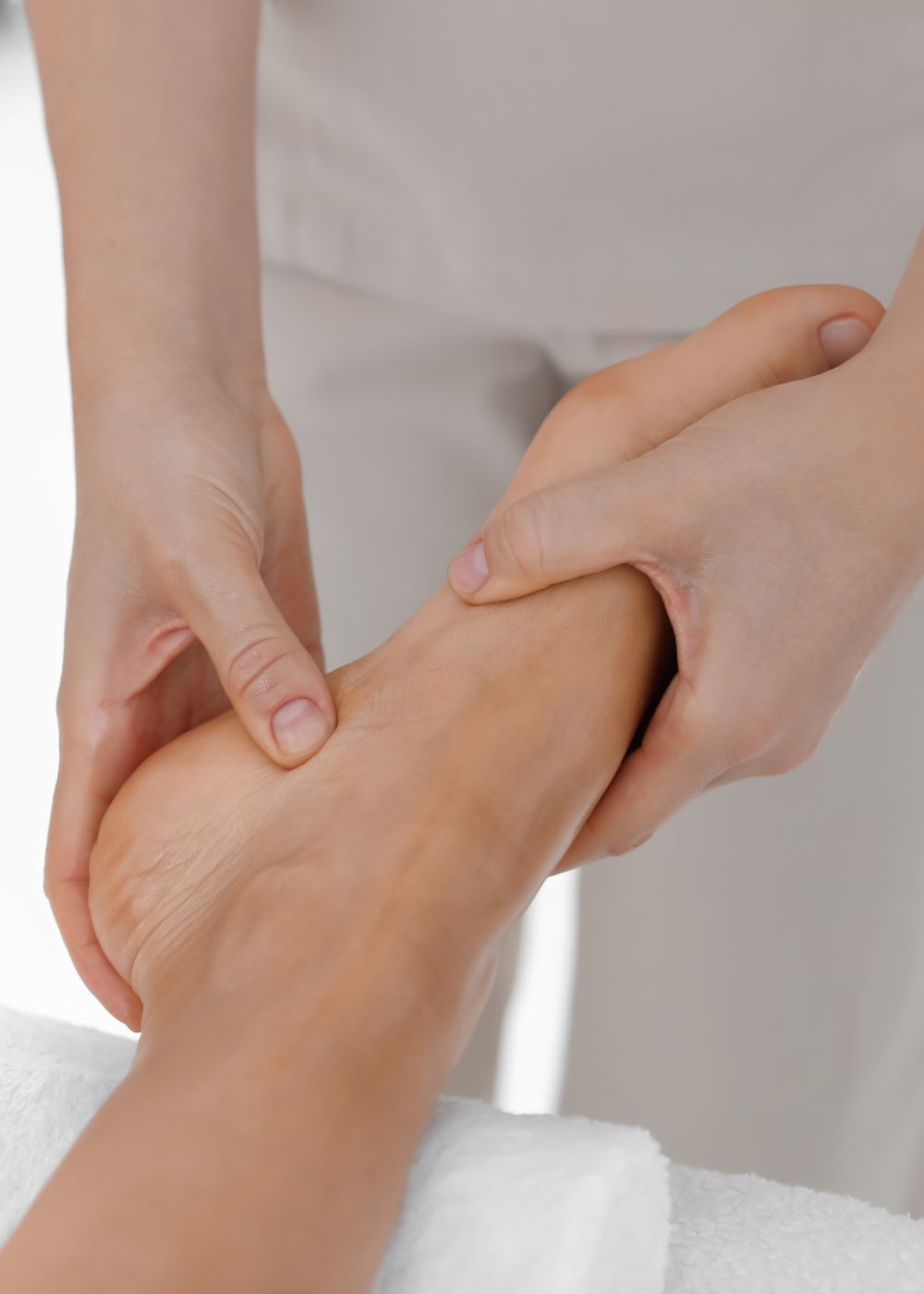Ankle Sprains in
New York City
Ankle Sprains Injury
Ankle sprains are common, with more than 25,000 people spraining their ankles in the U.S. every day. Because of this, many people consider ankle sprains insignificant and often ignore them, only seeking treatment when the injury is quite far along. The fact remains that each ankle sprain is different and based on the mechanics of the sprain — how it happened, which direction things twisted, etc. Due to these various aspects, the treatment, recovery time, and prognosis are different. If not properly evaluated early and treated, ankle sprains often develop into more serious, painful, longer-term problems like chronic ankle instability and/or arthritis at the ankle joint.
Treatment

What Causes Ankle Sprains?
Simply put, ankle sprains are caused by unnatural ankle twisting. The abnormal forces placed on the ankle bones and the bones of the foot during a sprain often result in one or more ligaments on the outside (or, less commonly, the inside) of the ankle being stretched or torn. This ligament stretching and/or tearing causes the swelling, bruising, and immense pain associated with ankle sprains.
“R.I.C.E.” – Rest, Ice, Compress, and Elevate
If you have sprained your ankle, there are a few things you can do immediately to ensure that you start treating this right, even before going to your podiatrist and getting evaluated. Initial treatment is “R.I.C.E.” — Rest, Ice, Compress, and Elevate:
- Resting the ankle and applying ice to reduce swelling is very important in the initial 72 hours.
- Icing the ankle as soon as possible after the injury is key. Think about what happens when a football player falls on the field. The team doctor doesn’t come running with three Advil and a cup of water; they come running with ice! Ice is an immediate anti-inflammatory as it causes vasoconstriction, reducing blood flow to the area that would cause this area to swell.
- Compressive bandages also may be used to immobilize and support the injury, though many store-bought, over-the-counter wraps are too compressive; improperly applied, they can do more harm than good.
- Elevation is key. Keeping your foot level (i.e., outstretched on a sofa or up on a chair) is the bare minimum. Ideally, you would prop your leg up on a number of pillows and try to get your foot and ankle above the level of your heart. This prevents swelling, which increases the pain and the likelihood that this will heal more slowly. You wouldn’t get up and walk or stand more than go from bed to your couch or a quick trip to the restroom. The less you are in an upright/vertical position, and the more you lie down with your leg elevated and your ankle iced, the better.
One word of caution: It is possible to over-ice your foot and ankle, so be careful to limit the ice to 20 minutes an hour when icing your ankle. Ideally, you would follow a cycle of 20 minutes of icing followed by 40 minutes of no ice and then repeat. There is no need to ice when sleeping, but keep your leg outstretched and even on a pillow if you can.
Call Chelsea Foot and Ankle at (646) 929-4149 in New York City for ankle sprain treatment.
How Do I Know If I Have a Sprained Ankle?
Common causes of a sprained ankle include falling or tripping, walking over uneven terrain, or participating in sports activities that involve jumping or running, such as trail running, soccer, football, or basketball. While each sprained ankle is different, you may experience some of these common symptoms:
- Pain, while at rest and with movement
- Swelling
- Bruising
- Tenderness to the touch
- Instability, such as feeling as though your ankle can’t support your weight
If you have participated in the above activities and/or are experiencing some or all of these symptoms, you may have sprained your ankle.
When Do I Need to See a Doctor for My Sprained Ankle?
If you feel that you have sprained your ankle, it’s always a good idea to schedule an appointment with your podiatrist to evaluate the severity of your sprain and to eliminate the risk of prolonged damage. However, some minor sprains are manageable at home if you follow the R.I.C.E. protocol.
If swelling and pain persist for more than 24 to 48 hours, seek an examination with your podiatrist as soon as possible.
Why Choose Chelsea Foot and Ankle to Treat Ankle Sprains?
Our team considers every patient as part of the family, and you can expect to be treated like the VIP you are. We respect you, your time, and your wallet by offering comprehensive services at reasonable prices customized to meet your needs.
Your visit will be tailored to your specific needs from start to finish. Dr. Ethan J. Climent has extensive experience regarding a wide range of podiatry issues and treats each case and patient as individuals — with care and compassion.
What Can I Expect from an Ankle Sprain Examination?
When you see your podiatrist, they will need to evaluate your ankle sprain. Much of this is done via physical examination. Depending on what they find on the physical exam, they might decide to perform an x-ray to ensure that there wasn’t a fracture associated with this sprain. Sometimes an ultrasound or sonogram of the ankle can help identify the injured soft tissue structures. In more severe cases or sprains in athletes, your doctor may need to send you out for an MRI, which gives the most detail on both the bone and soft tissue injuries. It can also be very helpful in staging your ankle sprain, which can help determine your course of treatment and recovery time.
Ankle Sprains Are Typically Classified into a Staging System:
Grade 1 Ankle Sprains are the least severe type of ankle sprain. Typically, the damage is minor and limited to stretching of the ligament(s). This kind of ankle sprain is usually associated with mild to moderate soreness and minor swelling, but it is not associated with ankle instability or muscle weakness. These sprains typically take two to four weeks to heal when patients seek early diagnosis and care. Staying off is critical to ensuring this is more of a two-week than a four-week recovery.
Grade 2 Ankle Sprains are the next level of ankle sprain. One of the distinguishing factors is the bruising associated with more significant swelling. This bruising (black and blue marks often appearing on the heel’s inner or outer sides) is a tell-tale sign that a ligament was partially torn. These injuries should not be self-treated and require medical supervision and intervention. Often, doctors will use some sort of brace or boot to help stabilize the ankle after a Grade 2 ankle sprain to minimize movement around the partially torn ligament(s), allowing them to heal better and faster.
When there is early intervention, diagnosis, and treatment, Grade 2 ankle sprains typically heal within six to eight weeks. Grade 2 sprains that do not get treated in the initial few days of the injury can lead to more than two months of pain and swelling, in addition to delayed healing of the ligament, causing scar tissue to form.
Grade 3 Ankle Sprains are severe and associated with extensive bruising and swelling from total rupture of one or more ankle ligaments. These must not be treated at home, and they require early and aggressive intervention to stabilize the ankle, take the pressure off these injured ligaments, and avoid permanent damage to the ankle joint. These injuries are often associated with an avulsion fracture — a type of fracture where a tiny little chip of bone rips off the tip of one or more of the ankle bones when the ligament is torn.
Recovery time from Grade 3 ankle sprains is quite variable. It depends on several factors, including the injured person’s health and fitness, age, activity level, and how quickly they came in for treatment. Recovery times range from three to six months but can take longer.
The most serious ankle sprains, especially in competitive athletes, may not heal properly despite all of the best interventions. In those cases, they require surgery to repair or tighten the torn ligaments.
How Can I Prevent Future Sprains?
Stretching before physical activity, performing strengthening exercises, paying attention to walking and running over uneven surfaces, and wearing supportive footwear during physical activity are all great ways to help prevent future sprains.
Ankle Sprain Treatment in Central New York City
Our highly skilled and knowledgeable doctors at Chelsea Foot and Ankle will guide every aspect of your visit. All of your questions, concerns, and requests will be considered carefully to ensure you have control over your foot and ankle care.
In addition to ankle sprain treatment, we also treat a variety of conditions, from common foot and ankle issues to sports medicine and surgery.
Ankle Sprains FAQ
Is there a way to speed up recovery from a sprained ankle?
The best way to speed up recovery from a sprained ankle is to follow your doctor’s instructions and to keep the weight off the ankle as long as possible. The more you rest, the better you will heal and the sooner you can return to normal.
What if my sprained ankle isn’t improving?
If you haven’t seen improvement with at-home care, it’s definitely time to make an appointment. If you have not been elevating your ankle or are putting too much strain on it, you may be causing more harm. It’s always best to seek medical care even if you think the sprain is minor or you have cared for a sprain at home — especially if your condition is not improving.
What are the risks associated with repetitive sprains?
Without proper treatment and rehabilitation, a chronic or repetitive sprain may result in a weakened ankle, making re-injury more likely. Repeated injuries may even result in chronic ankle pain, arthritis, and instability.
Will I need surgery for my sprained ankle?
Surgical treatment for a sprained ankle is rare. Usually, a sprained ankle can heal with conservative and at-home care, but if nonsurgical treatment has failed, surgery might be an option.
Why Choose Chelsea Foot and Ankle?
Our team considers every patient as part of the family, and you can expect to be treated like the VIP you are. We respect you, your time, and your wallet by offering comprehensive services at reasonable prices customized to meet your unique needs.
Are you interested In healing your ankle sprain?
If you are suffering from pain from an ankle sprain in central New York City, call our office today at (646) 929-4149!
Remember to check out our blog and patient testimonials to learn more about us!
We always put our best foot forward…so you can too!
Our Patients Love Us
An absolutely amazing experience. Dr. Ciment is an absolutely wonderful person – it is very evident that he truly cares about his patients.
What a pleasure to meet Dr. Shastri. She was extremely personable, listened intently and actually was able to treat my condition to a fair extent in the first sitting.
Highly recommend her.
